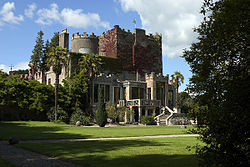Huntington Castle, Clonegal
| Huntington Castle | |
|
County Carlow | |
|---|---|
 Huntington Castle | |
| Location | |
| Grid reference: | S914607 |
| Location: | 52°41’23"N, 6°38’55"W |
| Village: | Clonegal |
| History | |
| Built 1625 | |
| Information | |
| Owned by: | Alexander Durdin Robertson |
Huntington Castle, also known as Clonegal Castle, is a castle in Clonegal, County Carlow, built in 1625.
The structure was originally a "plantation castle",[1] used for defensive purposes during the plantation of the area in the early 17th century. The original tower house, which served as a garrison, was built in the 15th century as a stronghold for the Caviness family, an old Irish clan. Later Baron Esmonde.[2]
Due to the strategic importance of the village of Clonegal during the Cromwellian conquest of Ireland because of its location on the road between Dublin and Wexford, the castle was captured by Oliver Cromwell as he marched on Kilkenny[2] in 1650.
The castle is now a private house, opened to the public for guided tours throughout June, July, August and September.
In the 1960s Olivia Robertson, sister of the owner, declared herself to be a priestess of Isis and established a temple in the basement, later founding the 'Fellowship of Isis', which apparently remains there,[3] though the castle's visitor site does not mention it.
The castle is now owned by Alexander and Claire Durdin Robertson.
Gardens
The Esmonde family laid out most of the gardens in the 17th century. This includes the French limes on the Avenue, the parterre or lawns to the side of the house, the fish ponds on either side of the centre walk through the wilderness and the majority of yew trees which comprise the Yew Walk. Larger plantings have resulted in Huntington possessing a number of great Irish trees, including varieties of hickory, a cut leaved oak, Siberian crab and buckeye chestnut.
A lake at the bottom of the wilderness was built for ornamental purposes but next to it is one of the earliest water turbine houses in Ireland, providing Huntington with its own electricity as early as 1888.
The River Derry, which forms the border between the counties of Wexford and Carlow, flows along the bottom of the wilderness, providing a pleasant setting for woodland walks.
On film
The castle was used as a filming location in Stanley Kubrick's film Barry Lyndon.
Outside links
References
- ↑ Williams, Jeremy (1994). A Companion Guide To Architecture in Ireland 1837 - 1921. Irish Academic Press. p. 39. ISBN 0-7165-2513-5.
- ↑ 2.0 2.1 Heron, Marianne (1999). The Hidden Houses of Ireland. Gill & Macmillan Ltd.. pp. 28–30. ISBN 0-7171-2730-3.
- ↑ Rowan Kelleher, Suzanne: 'Frommer's Ireland' (John Wiley and Sons, 2004), 14th edition page 177, ISBN 0-7645-4216-8